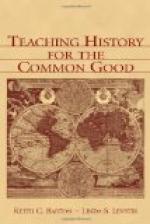1. What States are included in the purchase?
2. What is its
area? How does it compare with the area of the
original
thirteen States?
3. What geographical reasons caused Napoleon to sell it?
4. What influence
did the purchase have on our retention of the
territory
east of the Mississippi? Why?
5. How many people
live to-day in the territory included in the
purchase?
His power of analysis and criticism will be stimulated
A lesson should be so assigned that the student will read the text with his eye critically open to inconsistencies, contradictions, and inaccuracies. With a text of six hundred pages, and with a hundred and eighty recitations in which to cover them, it is not too much to expect that the average of three or four pages daily shall be studied so thoroughly that the student can analyze and summarize each day’s lesson. The teacher should not make such analysis in advance of the recitation, but he should so assign the lesson that the student will be prepared to give one when he comes to class. A word in advance by the teacher will prompt the student who is studying the American Revolution, to classify its causes as direct and indirect, economic and political, social and religious. There is no difficulty in finding good authorities who disagree as to the effect on America of the English trade restrictions. Callendar’s Economic History of the United States quotes five of the best authorities on this point, and covers the case in a few pages. A reference by the teacher to this or some other authority will bring out a lively discussion on the justice of the American resistance. Let the class be asked to account for the colonial opposition to the Townshend Acts, when the Stamp Act Congress had declared that the regulation of the Colonies’ external trade was properly within the powers of Parliament. Let the class be asked to explain a statement that the Declaration of Independence does not mention the real underlying causes of the Revolution. A few suggestions and advanced questions of this sort will stimulate a critical analysis of the statements in the text, and send the student to class keen for an intelligent discussion.




